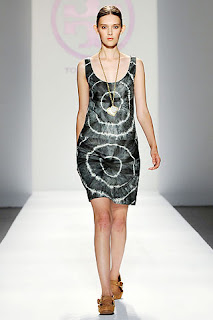The Zoot Suit
Popularized by African Americans and Latinos in the 1920's and 30's, the zoot suit was high-waisted and wide-legged, with tight-cuffed pegged trousers, a long coat with wide lapels and wide padded shoulders. It was often worn with a felt hat, pointy shoes, and a watch chain that hung from the belt to the knee or below, and back to a side pocket.[1] Zoot suits were worn on important occasions and were considered luxury items due to the large amount of material and tailoring necessary to make them. During WWII, the zoot suit was officially abolished by the US War Production Board because it was considered a waste of textile materials.[2] Those that continued to wear the Zoot Suit were considered to be rebellious, though it was also a declaration of freedom by young minorities in America.
The images below display John Galliano's modern interpretation of the Zoot Suit from his 2002 RTW collection: the pants are still high-waisted and wide-legged, while the suit coat is long with wide-lapels. There may be no watch chain here for effect, but Galliano made sure to add the pointy shoes to complete the look.
Teddy Boys
The Teddy Boy subculture started in England in the 1950’s by young men who wore clothes styled after the Edwardian period. Teddy Boys became associated with American rock and roll music and were the first youth group to differentiate themselves as teenagers.[3] The Teddy Book look included “long drape jackets, usually in dark shades, sometimes with velvet trim collar and pocket flaps; high-waist "drainpipe trousers, often showing brightly coloured socks. Favoured footwear was chunky brogues, large crepe-soled shoes, often suede (known as brothel creepers). Plus a high-necked loose collar on a white shirt (known as a Mr B. collar because it was often worn by jazz musician Billy Eckstine); a narrow Slim Jim tie, and a brocade waistcoat.”[4]
Modern interpretations of the Teddy Boy look from Jens Laugesen's Spring 2008 and Fall 2008 RTW Collections are shown below. From Laugesen's Spring collection we see a long, gold lame tux jacket with satin trim, and an electric-blue brocade "bomber" jacket complete with velvet trim, both reminiscent of the Teddy Boy trend. The last image is from Junya Watanabe's Spring 2007 RTW collection showcasing a modern drape jacket, "drain-pipe" trouser pants, and high neck collar on a white dress shirt similar to a "Mr. B" collar favored by the Teddy Boy subculture.

Beatniks
The term Beatniks comes from the “Beat Generation” of the 1940’s and is characterized as an underground, anti-materialistic, anti-conformist youth movement that “stressed artistic self-expression and the rejection of the mores of conventional society”.[5] Characteristic looks include black turtleneck sweaters and berets on men with goatees, who rolled their own cigarettes and played the bongos. Women wore black leotards and had long, straight hair as an act of rebellion against beauty salons.[6]


The below images show Max Azria's Fall 2006 RTW modern interpretation of Beatnik fashion: chunky turtleneck sweaters and berets on long, straight haired models donning black stockings or high boots.
Mods
The mod subculture began in London in the late 1950’s and hit its height in the 1960’s. The mods were young people who enjoyed rock-and-roll, were fashion-obsessed, and drove sporty Italian scooters as they were cleaner than motorcycles and less likely to stain the mods expensive clothing.[7] Male mods often wore sophisticated, stream-lined, tailor made suits “with narrow lapels, [or] mohair clothes, thin ties, button down collar shirts, [and] wool or cashmere sweaters”.[8] Female mods often preferred an androgynous look “with short haircuts, men’s trousers or shirts, . . . flat shoes and little make-up”.[9] Female mods also began wearing miniskirts. The model Twiggy is a popular example of a high fashion mod female.
The androgynous look, often worn by female mods in the 1960's, can be seen in many modern collections. Below are two images from Undercover designer Jun Takahashi's Fall 2004 RTW collection, which displays mod trend androgyny through men's shirts and pants (paired of course with flat shoes). The next two images display modern versions of the miniskirt in Phoebe Philo's leather miniskirt design for Celine's Fall 2010 RTW, and Versace's Pre-Fall 2010 "mini-suit" design.




Hippies
The hippie subculture began in the US during the 1960’s as an anti Vietnam war, anti-establishment movement that criticized the values of the American middle class, “embraced Eastern philosophy, championed sexual liberation, were often vegetarian and eco-friendly, promoted the use of psychedelic drugs” and lived in communes.[10] Hippies believed that American government and culture was corrupt and opted for an ideological lifestyle based on “peace, love and personal freedom”.[11] Hippies had their own unique appearance characterized by colorful ethnic clothing, jeans, or even nudity.


Hippie-chic inspired clothing has recently been seen on the runway in just the last two years, as many designers have incorporated "Bohemian" looks into their designs. The first image shows a tie-dye dress from Tory Burch's Spring 2010 collection. The second, third and fourth images are from Etro's Spring 2008 RTW collection with multi-colorful, ethnic prints depicting strong influence from 1960's hippie fashion.
Disco
Based on a genre of dance music in the 1970's, disco officially became a popular part of mainstream culture in 1977 with the release of Saturday Night Fever starring John Travolta. Disco fashions included “sheer, flowing Halston dresses for women and shiny polyester Qiana shirts for men with pointy collars, preferably open at the chest, often worn with double-knit and polyester suit jackets with matching trousers known as a leisure suit.”[12] The third and fourth images display popular 1970's disco influences on today's fashion: that of the jumpsuit, and one-shoulder, silky, flowing dresses reminiscent of the Halston dresses worn by women in the disco era. Both images are from BCBG Max Azria's 2009 RTW collection.
The punk subculture emerged in the US and in Europe in the mid-1970’s around a genre of loud, aggressive rock music called punk rock.[13] Like other street trends, punks had a unique style that included “highly theatrical clothing, hairstyles, cosmetics, tattoos, jewelry and body modification.”[14] Punk fashion predominately included combat boots with tight jeans, oversized T-shirts and outrageous hairstyles” such as the Mohawk, that was often colored in loud, vibrant hues.[15] Leather, rubber and vinyl are popular fabrics for punk clothing, which is often adorned by pins, buttons, and metal studs or spikes.[16]
One designer credited with bringing punk fashion to mainstream culture, is Vivienne Weswtood, often referred to as the queen of punk rock fashion. Westwood's personal relationship with Malcolm McLaren, manager for the popular punk rock band, The Sex Pistols, made her designs a hit amongst punk rockers. The first two images below are from Westwood's 2010 Spring RTW collection. The highly theatrical runway punk hair and make-up compliment Westwoods draped, asymmetrical designs with unfinished or torn edges, and chaotic prints reminiscent of 1970's punk rock music and style.
The next three images are designs by Christophe Decarnin for Balmain, showcasing a modern interpretation of 1970's punk fashion. The first two images depict the "rocker look": with tight pants in leather and slashed camouflage, paired with baggy, torn tees, combat boots and military jackets adorned with metal embellishments. Even Decarnin himself, pictured in the third image, complimented his women's RTW collection with his own punk rock look.
Hip Hop
Hip hop culture emerged during the late 1970’s in low-income, African American and Latino American urban cities with the epicenter of the hip hop music scene occurring in the South Bronx, NY. “B-boying (breakdancing), graffiti writing, DJing and eMCeeing [was] an artistic commitment to seize freedom from oppressive social conditions.”[17] Hip hop fashion originally included such trends as “brightly colored name-brand tracksuits, sheepskin and leather bomber jackets” worn with sneakers that had “phat” or oversized shoe laces.[18]Accessories included large sunglasses, bucket hats, and heavy gold jewelry. In the 1990’s hip hop fashion for men was characterized by sportswear with large logos such as Tommy Hilfiger, throwback jerseys, baggy pants, and work boots.[19] Female hip hop artists began to distinguish themselves from their male counterparts by glamorizing hip hop fashion with high-end designer clothing and accessories. Hip hop fashion today includes "slim-fit denim jeans, tighter-fitting "vintage style" t-shirts with shorter arm sleeves, polo shirts, sport coats, woven button shirts, large ornamental belt buckles, cufflinks, skull and skeleton decorations, [biker chains], tattoo inspired motifs, elaborately decorated zip-up hoodies, trucker hats, lumberjack button-ups or plaid designed shirts, and snow inspired fashions.[20] High-end fashion designers are also very popular in today’s hip hop fashion culture.
These last images are from Sean John's Fall 2008 Men's runway collection, showcasing how hip hop fashion has in a sense "grown-up". Sean John clothing, started by and named after hip hop mogul Sean "Diddy" Combs. Comb's commercial success as a hip hop icon led him to develop his own urban clothing line in 1998. In 2004, Sean John Clothing received the Council of Fashion Designers of America (CFDA) award for Men's Designer of the Year.[21]
New Street Trends
Second-hand clothing from the street to the runway
Thrift stores have long been cool places where the "street savy" shopped for affordable clothing, but thanks to the vintage fashion trend and the recession, this once typical street trend originally viewed by most of society as clothing for the destitute, has now become middle class "chic". However, it's not simply the economy that's driving more and more people to shop in second hand clothing stores, it's also due to environmentalism and social responsibility. The whole "green" lifestyle beginning with the recycling of plastic bottles and cans has spread into a concept of sustainable or eco-fashion in which people feel good about buying and selling recycled clothing as a way to help the environment. While there is nothing really new about this trend on the street, the fact that it is becoming more mainstream and now making it's way onto the runways of well-known designers is a perfect example of the upward-flow theory. The second and third images are recycled clothing designs by John Patrick from his Fall 2009 RTW collection and a recycled Greg Harvey gown presented at London's Fashion Week in 2007.

Gender Inversion
Although it may not be a completely new concept, and certainly not one seen often on American streets, in Japan, more and more men are employing traditional female skirts into their ensembles. Japanese men may feel more comfortable wearing this trend, considering the traditonal Japanese yukata; however, it is important to note that the yukata has only recently regained popularity in Japan, as it was practically abandoned as street wear after WWII. This sort of unisex or perhaps a gender inversion trend is becoming more prominent on men's runways for Spring 2010 as designers such as Rei Kawakubo for Comme des Garcons and Yoji Yamamotos' Fall 2009/2010 collections incorporate the skirt into their men's lines (displayed in order in the last three images).
[3] http://en.wikipedia.org/wiki/Teddy_boy
[4] See Id.
[8] See Id.
[9] See Id
[10] http://en.wikipedia.org/wiki/Hippie
[11] See Id.
[12] http://en.wikipedia.org/wiki/Disco
[20] See Id. [21] http://ezinearticles.com/?Sean-John-Clothing---The-Facts&id=3220179










































That was just a very, very interesting read. Thanks for posting this!
ReplyDeleteHey--Desperately trying to find links to two of your pics. Can youplease get in touch? Thanks
ReplyDeletethanks
ReplyDelete